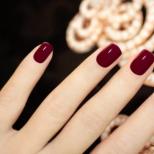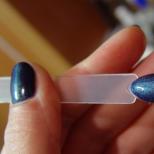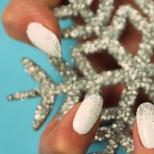How to remove shellac from nails at home
How to remove shellac from nails, what methods of removing shellac coating exist, and whether it can be removed at home, you will learn from the article.
Every girl is familiar with such a novelty of manicure as a shellac coating. Shellac is an innovative nail polish that has the properties of a gel. A durable nail coating developed by an American company is popular all over the world. Compared to regular nail polish, shellac lasts longer on nails, averaging about three weeks.
Distinctive features of the shellac coating are that the application occurs without cutting off the top layer of the nail. At the same time, a special technology is observed using an ultraviolet lamp and professional tools (base and top).
Shellac gives the master incredible scope for design. Drawings, sequins, rhinestones and other decorative elements, the effect of broken glass, a classic or colored jacket - all this can decorate shellac-coated nails. The procedure is more in demand than a manicure with ordinary varnish and extensions. Unlike extensions, shellac is a more gentle option, it damages the nail plate less, and is not inferior in effectiveness.
The main advantage of shellac manicure is durability. It is also associated with the features of removal. Regular nail polish remover won't work. Manicurists strongly recommend seeking help from a beauty salon, but sometimes this is not possible. For example, a manicure was damaged during a vacation or a nail master cannot accept it in the near future. Then there is a need to remove shellac yourself at home. This is real if you know the features and follow the rules for removing shellac.
Methods for removing shellac without a special liquid
To remove shellac without resorting to the help of a specialist, you will need the following tools: acetone or acetone-containing nail polish remover, isopropyl alcohol, aluminum foil, cotton pads or cotton swabs, and an orange stick are also suitable. Technical acetone should not be used. It injures the skin, cuticles and even the nail plate.
Consider two simple but effective ways to remove shellac without a special liquid.
Option number 1
Before the procedure, make sure that the product does not cause allergies. To do this, apply a small amount on the inner surface of the elbow. If after ten minutes there is no redness or irritation, carry out the procedure.
Prepare the components necessary for the procedure. Split cotton pads and cut into two halves - semicircles. If ordinary cotton wool is used, small cotton pads are formed. 10 squares are cut out of foil so that everyone can wrap a finger. Wash your hands in warm water with soap, this will degrease the skin and allow for a more effective procedure.
- Moisten the cotton with plenty of nail polish remover. Apply the moistened swab very carefully, avoiding contact with the skin and cuticles to prevent burns.
- Wrap the nail with cotton tightly applied with foil. To fix cotton sponges, ordinary office rubber bands are also suitable. Do this with each finger.
- The design is left on the nails for 10-15 minutes, after which it is removed alternately from each finger. It is recommended to remove cotton wool with rotational movements, so it will be possible to remove more varnish.
- Most of the coating should come off the nail immediately after removing the foil, the remains are removed with an orange stick.
An orange tree stick can be replaced with a pusher - this is a metal spatula for pushing back the cuticle. The pusher will need to work more carefully, gently press on the tool, since the metal can damage the nail plate when pressed hard. If the shellac does not lag behind the nail plate, the procedure is repeated for several minutes.
The shellac removal procedure is completed by polishing with a buff (this is a polishing block that is softer than a file, helps smooth out uneven nails, and bring the manicure to perfection). They remove the smallest remnants of the coating, and the shape of the nail is honed. A polishing file will also work. To prevent dryness and thinning of the nails, cuticle oil is applied with light massage movements.
Video instructions
Option number 2
The second method is easier and faster than the first, but has disadvantages. It is less gentle, and aggressively affects the nails and skin of the hands.
- Before the procedure, wash your hands with warm soapy water. The upper shiny layer of shellac is sawn off with a grinding file.
- The skin around the nails is smeared with a greasy cream. For 10 minutes, immerse the nails in a bath with acetone or concentrated nail polish remover. You can immerse one at a time, if the size of the container allows, soften the coating on both hands at once.
- Carefully remove the film of varnish with an orange stick, try not to damage the nail plate. Wash your hands thoroughly in warm water using mild soap.
- As in the first option, we treat the nails with a buff and lubricate the cuticle with special oil.
After the transferred stress nails and hands need recovery. To do this, lubricate them well with a nourishing cream. To make the skin of the hands recover faster, become tender and soft, make a special mask that will moisturize the skin of the hands and nourish it with useful substances.
The listed ways to remove shellac at home will help save money and not resort to a visit to a nail salon.
Professional methods for removing shellac

It is easier to remove the shellac coating than the gel that is used for extensions. In order for the procedure to pass quickly and without negative consequences for the nails, you should contact the specialists in the salons. In nail salons, specialized tools are used that will allow:
- Completely remove the gel polish from the nail plate without leaving even the thinnest film. The thin transparent layer of coating remaining on the nails will spoil the future manicure, deprive it of both aesthetics and strength.
- Prepare the base for the next manicure, which will allow you to look perfect.
- Strengthen nails with nourishing and moisturizing ingredients.
To simplify the task of removing shellac, professional kits are used. They are suitable for both salon and home use.
The standard set contains a shellac dissolver, an orange stick, disposable nail sachets, a professional nail file and cuticle oil.
In specialized salons, only professional products are used and the technology for removing shellac coating is as follows:
- Shellac remover is applied to cotton sponges that look like ordinary fingertips. They are put on each finger and fixed with Velcro. Thus, the liquid gradually corrodes the coating without affecting the skin.
- After 10 minutes of exposure, the sponges are removed, and the remnants of the softened gel are removed with an orange stick.
Video tips
Professional masters use high-quality products in their work, which during the procedure saturate the nails with caring components. Immediately after this, you can apply a new coating, this will not damage the nails.
Types of liquid for removing shellac

The choice of liquid for removing shellac should be taken very seriously. A durable coating is difficult to remove, so some liquids act aggressively not only on the varnish, but also on the nail plate.
Any shellac remover contains acetone or its analogues, for example, acetylate, solvent. These chemical compounds break down gel polish well, but the side effect of use is the dryness of the nail plate. Another component often included in many liquids, isopropyl alcohol also adversely affects the nail.
To neutralize or reduce the negative impact of chemical elements on the nail, well-known brands supplement the composition of liquids with vitamins A and E, petroleum jelly, glycerin, disinfectant additives, plant extracts and essential oils. Useful for nails are castor, lemon, almond oils, tea tree extract, decoction of wheat germ. Some manufacturers produce such a nutrient liquid with the name “smart enamel”, because it provides safe comprehensive care and promotes a healthy appearance.
If the product does not contain nutrients, it is imperative to use cuticle oil after each shellac removal procedure. This will prevent overdrying of the cuticle and nail plate. It is strongly not recommended to remove the coating with concentrated acetone. It aggressively affects the nail plate, provokes delamination of the nail and, penetrating the body through the skin, poisons with toxins. In order not to harm your health, use a quality shellac remover.
Consider the most popular liquids.
- Liquid firm CND (Shellac) gently removes varnish in an extremely short period of time - 8 minutes (standard 10-15 minutes). The vitamin E and macadamia nut oil included in the composition moisturizes, preventing overdrying of the nail plate and cuticle and the appearance of white spots on the nails. Some brand liquids have a pleasant smell (CND Product Remover).
- Manufacturer color Couture entity One releases goods in containers with a very convenient dispenser. The protective layer of the nail plate creates lanolin, which prevents dryness and irritation.
- Company fluids Gelish Harmony, Jessica Gelation,GelFx Orly dissolve the varnish in 10 minutes without harming the natural nail plate.
- Firm Astonising produces liquids that are suitable for removing not only shellac, but also gel polish and acrylic.
- More versatile brand tools IBD Just Gel. They remove any types of coatings from the nail plate: gel polishes, acrylic, tips, fiberglass. In addition, the composition includes clotrimazole - an antifungal and antibacterial agent. Thus, there is not only protection, but also treatment of the nail.





